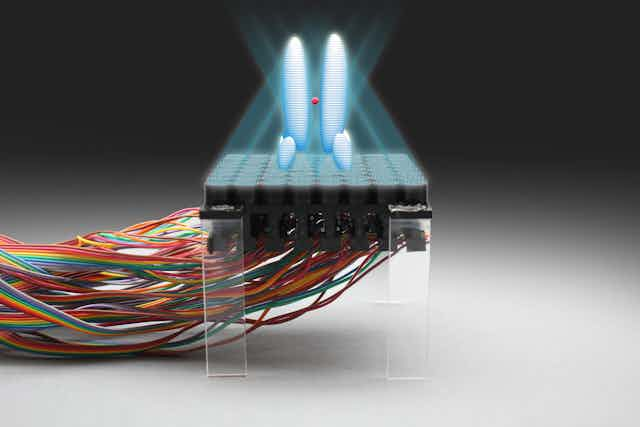Ultrasound can do a whole lot more than create images of unborn babies. Since it first became a near-indispensable medical tool in the 1930s, technology that produces sound waves so high-pitched that humans can’t hear them has found use in almost every branch of industry. The vibrations it creates can kill bacteria, weld plastics and even help to mature brandies in a matter of days rather than years.
Today, ultrasound is finding its way into even more applications, powering inventions that have the potential to make huge changes in their fields. Here are just a few of them:
1. Truly hands-free phones
We are on the brink of a real contactless alternative to touch-screen technology. Devices like the Microsoft Kinect can detect where you hands are and use that information as instructions. But placing your hands in exactly the right place to give the instructions you want to is still tricky enough to prevent this kind of gesture-based control system from being used more widely.
One company is using ultrasound to effectively create invisible buttons in the air that you can feel. An array of ultrasound transmitters produces and shapes sound waves to create small areas of force sensations on the skin in a specific location. So instead of waving your hand around and hoping it’s in the right place, you know instantly when you’ve activated the gesture recognition.
This has the potential to make everyday devices such as smartphones completely waterproof, contactless and effectively aware of the surrounding environment. The technology can also be combined with virtual reality systems to enable you to feel your artificially generated surroundings, which would bring a new dimension to video games and entertainment.
There are rumours that the next generation of smartphones will use ultrasonic fingerprint recognition so you don’t even need to touch your phone to unlock it. These phones could even incorporate ultrasound for wireless charging, where ultrasound energy could be converted to electrical energy within the phone. This energy would be projected from a transmit unit stored, for example, on the wall in your house.
2. Acoustic holograms
Ultrasound has long been used to create two-dimensional images of the body for doctors to study. But a very recent development that is likely to feature prominently in healthcare in the future is the ultrasound acoustic hologram.
In this technique, ultrasound is used to move micro-particles in a particular medium to form a desired image. For example, projecting sound waves through a specially-designed patterned plate into water containing plastic particles forces them into a particular alignment. Researchers think this kind of acoustic holography could be used to improve medical imaging but also to better focus ultrasound treatments.
3. Glasses for blind people
Another potential medical application of ultrasound is to enable blind people to “see” in a similar way to how bats do using the principle of echolocation. Rather than detecting reflected light waves to see objects, bats send out ultrasound waves and use the reflected sound to work out where things are. These echoes can provide information about the size and location of that object.
Researchers in California have created an ultrasonic helmet that sends out similar ultrasound waves. It then converts the reflected signals into audible sounds that the human brain can learn to process into a detailed mental image of the environment. In time, this technology could become more practical and portable, perhaps even one day incorporated into specially designed glasses.
4. Tractor beams
Given enough power, it is possible to ultrasonically levitate objects just with sound waves, and move them in different directions, effectively like a science fiction tractor beam. Researchers from the University of Bristol have shown that by controlling and focusing sound waves from an array of ultrasound sources can create enough force to lift a bead-sized object off the ground.
Lifting larger objects, such as a human, would require very high power levels, and it is not fully understood how damaging the acoustic forces would be to a person. But the technology has the potential to revolutionise a range of medical applications. For example it could be used to move drugs around the body to get them to their target cells.
5. Martian scanners
Ultrasound technology is already being investigated as an exploration tool. At high power, ultrasonic vibrations can be used to efficiently compact material, like a kind of drill hammering its way through. This has been proposed for use in the search for underground oil and gas deposits. Ultrasonic echolocation can also be used as a type of sensor to help aerial drones avoid obstacles so they can be sent into dangerous and difficult-to-reach locations.
But exploration is not limited to Planet Earth. If humans are ever to visit Mars, we’ll need new ways of analysing the Martian environment. Because of the low gravity on Mars, conventional drills wouldn’t be able to press down with as much force, so researchers are looking at how ultrasonic devices could be used to collect samples instead.

